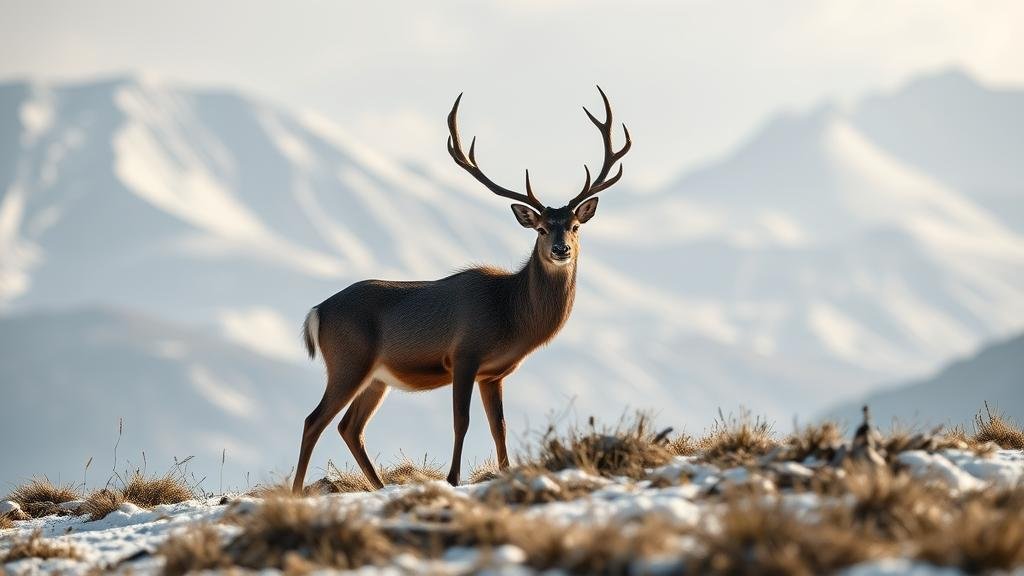Tracking the rare Himalayan musk deer in the snowy heights of the Himalayas.
Tracking the Rare Himalayan Musk Deer in the Snowy Heights of the Himalayas
The mystical landscapes of the Himalayas are not only famed for their towering peaks and breathtaking vistas but also for their rich biodiversity, including the elusive Himalayan musk deer (Moschus chrysogaster). This article explores the daunting task of tracking these rare creatures in their high-altitude habitats and highlights the ecological importance of their preservation.
The Himalayan Musk Deer: An Overview
The Himalayan musk deer is a unique species endemic to the mountainous regions of central Asia, particularly within the Himalayas. Characterized by their small stature, elongated bodies, and distinctive small antlers in males, these deer are primarily known for the gland that produces musk, a substance historically sought after in perfumery.
This species has adapted to its high-altitude environment, which encompasses the rugged terrains of Nepal, Bhutan, India, and northern Tibet. are typically found at altitudes ranging from 2,400 to 4,500 meters, thriving in the coniferous and alpine forests replete with dense underbrush that provides cover from predators.
Habitat and Behavior
The Himalayan musk deer is an agile climber, perfectly adapted to navigate steep, rocky slopes. During the winter months, snow covers their habitat, posing challenges for both the deer and those who seek to study them. Musk deer are primarily nocturnal, which means tracking them requires significant patience and strategic planning.
These deer rely heavily on their keen sense of smell and acute hearing to detect predators and navigate their environment. Understanding their behaviors–such as feeding patterns, mating rituals, and territorial movements–is crucial for conservationists and researchers in their efforts to monitor populations.
Conservation Status and Threats
According to the International Union for Conservation of Nature (IUCN), the Himalayan musk deer is classified as Near Threatened. The primary threats to their survival are habitat loss, poaching for musk, and the impact of climate change. The musk industry has particularly driven poaching, as the glandular secretion can fetch high prices in the market.
For example, market reports indicate that the cost of musk can reach up to $45,000 per kilogram. This lucrative trade has put immense pressure on the already vulnerable populations of musk deer, compelling conservationists to design targeted interventions to protect them.
Tracking Techniques
Tracking the Himalayan musk deer entails a combination of traditional field methods and modern technology. Techniques employed include:
- Trail Monitoring: Observing animal trails in the snow to identify movements and feeding sites.
- Camera Traps: Utilizing infrared camera traps to capture images of musk deer in their natural habitat, which helps in estimating population size and behavior.
- Radio Collar Tracking: Fitting select individuals with radio collars to monitor their movements and gather data on their habitat use.
These methodologies demand not only technical expertise but also a thorough understanding of the ecological dynamics of the Himalayan environment, as weather conditions can significantly alter tracking efforts.
Real-World Applications: Conservation Efforts
In recent years, conservation projects in the Himalayan region have gained prominence. For example, the Himalayan Musk Deer Conservation Project, initiated in 2020, brings together local communities and wildlife experts to develop sustainable practices that prevent poaching while enhancing habitat conservation.
Also, educational programs aimed at local populations have proven beneficial. Studies show that communities educated about the ecological importance of the musk deer are more likely to participate in conservation efforts, resulting in a noticeable decrease in poaching incidents.
Conclusion: Actionable Takeaways for Conservation
Tracking the Himalayan musk deer in the snowy heights of the Himalayas is an endeavor that requires significant scientific and community engagement. following actions can further enhance conservation efforts:
- Establishing and enforcing stricter anti-poaching laws.
- Increasing funding for conservation programs that focus on habitat restoration.
- Promoting ecotourism that emphasizes sustainable practices beneficial to local communities and wildlife.
In essence, the future of the Himalayan musk deer lies not only in dedicated research and tracking efforts but also in comprehensive community involvement and education, ensuring these enchanting creatures continue to roam the heights of the Himalayas for generations to come.



